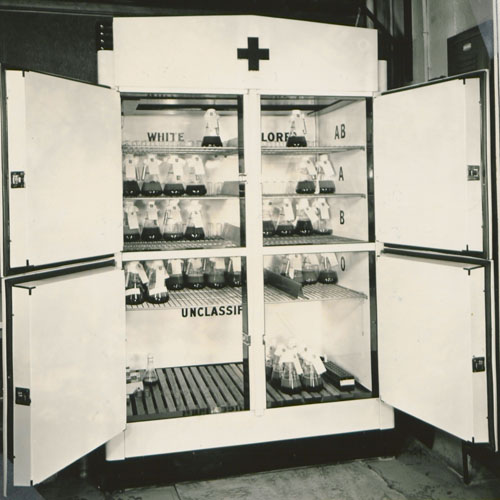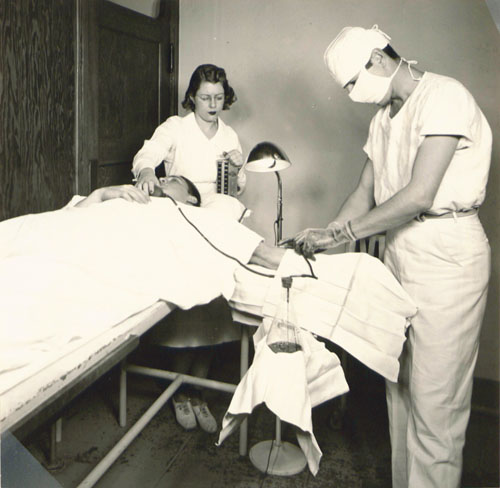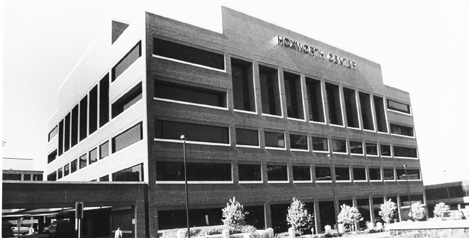If you have ever donated blood, you probably did not sit and think about the history of blood donation in the process. You likely were more concerned about the needle stick, watching that little bag fill up with your blood or avoiding doing so, or maybe you were already thinking about that cookie you could eat after it was all over. What you may not have realized was the important role the University of Cincinnati played in developing the modern blood donation process. Certainly, if you have ever donated blood in the Greater Cincinnati area, you have heard of the Hoxworth Blood Center, which is actually part of the University of Cincinnati. You may not have heard of its namesake, though. Dr. Paul Hoxworth was the founder of Greater Cincinnati’s blood bank. He helped to revolutionize blood donation, thereby saving countless lives.
Hoxworth, a Columbus, Ohio native, came to the University of Cincinnati to purse a Ph.D. after completing his medical degree at the Ohio State University. In 1938, he was appointed Assistant in Surgery at Cincinnati’s General Hospital (now University Hospital). At that time, General Hospital, like many other hospitals around the country, had trouble maintaining an adequate supply of blood to treat injuries and to replenish blood during surgery. In addition, the storage of blood and more accurate techniques for determining blood type were still being studied. The biggest problem in Hoxworth’s opinion though, was finding blood donors. At the time, friends and relatives were often asked to donate blood when someone was ill or injured but this was not a reliable method. In his dissertation, Hoxworth explained:
There are delays, inefficiency and tragic results attendant to locating friends and relatives and the laboratory search for compatible and suitable bloods for patients whose bloods are of the rare group. Occasionally there is an emergency which does not permit even the time used to select a donor for patients whose blood is of the common group. Any innovation in blood transfusion service which abolished these delays results in a decreased morbidity and the saving of lives. (p. 48)
Hoxworth made it a focus of his research to help abolish these delays in blood donations and find ways to keep adequate blood supplies available to area hospitals.
Doctors at General Hospital, like researchers around the world, investigated various ways of maintaining an adequate supply of reserve blood. The hospital conducted research on the use of cadaver blood, but was unable to find adequate cadaver donors and to produce enough blood to meet the hospital’s needs. In addition, doctors believed that patients would be unwilling to accept blood from a dead person. The hospital also conducted research on the use of fetal cord blood, but were still unable to procure an adequate supply of blood in an efficient manner.

Blood Storage, circa 1940. Note the separate areas for "White" and "Colored" Blood. Image from Paul Hoxworth’s dissertation
A momentous step towards a solution occurred on December 10, 1938 when the American Red Cross Transfusion Center opened at Cincinnati General Hospital as Cincinnati’s first blood bank. Costs were shared between the American Red Cross and General Hospital. The blood bank serviced all Hamilton County hospitals and physicians and operated 24 hours a day with a staff of 3 technicians, a secretary, and an occasional medical student. Dr. Hoxworth served as the first director and his wife, Nancy, worked as the secretary. The blood bank maintained a list of donors who could be contacted by phone day or night to donate blood. The blood bank accepted approximately 3400 donations in 1939.
The transfusion center was the height of scientific innovation and Hoxworth and his colleagues worked to improve blood transfusion methods. Yet, they were still hampered by their times. The blood was refrigerated and stored not only according to blood type, but also by race. As Hoxworth explained, “The separation of white and colored blood in the bank has been a constant practice for reasons other than scientific ones. As is true in other phases of the practice of medicine, society is not yet willing to accept what medicine already knows.” (Hoxworth’s dissertation, p. 81) What scientists knew was that there was no difference in the blood of a black person and a white person.
In 1944, the blood center became part of the University of Cincinnati, and was renamed the UC Blood Transfusion Service. In 1973, the blood bank was named after its founder as the Paul I. Hoxworth Blood Center and is currently called the Hoxworth Blood Center. Today the blood center has more than 260 employees, and distributes more than 300,000 blood components per year to 31 area hospitals in Ohio, Kentucky, and Indiana. The center needs 350 volunteer whole blood donors and 40 volunteer platelet donors each day to maintain an adequate supply of blood. Hoxworth’s central location is now located at 3130 Highland Avenue on the University of Cincinnati’s East Campus, but they also operate seven other neighborhood donation centers. Visit their website for further information on blood donation and other current projects: http://www.hoxworth.org/.html
The University of Cincinnati Libraries holds a number of sources for further research into the history of blood transfusion, the research of Dr. Paul Hoxworth, and the Hoxworth Blood Center:
The Archives and Rare Books Library holds some of the papers of Dr. Paul Hoxworth. This collection consists of his office files during the development of the UC Blood Transfusion Center, records of his involvement with the American Association of Blood Banks and the American College of Surgeons, along with Hoxworth’s research files, personal writings and research, reprints of writing and sources, books, and slides. A finding aid is available on the OhioLINK Finding Aid Repository.
Dr. Paul Hoxworth’s 1940 dissertation on Improvement in Blood Transfusion Service is available in electronic form through UC’s catalog.
The Winkler Center for the History of the Health Professions is also a great resource for further information on medical topics.
A special thanks goes out to Natalie Grieszmer of the Winkler Center for helping to locate some of these photos!



